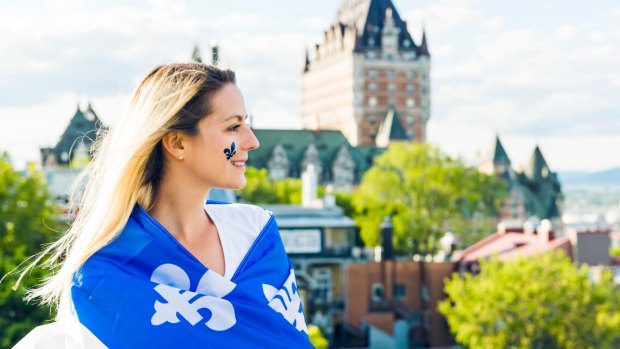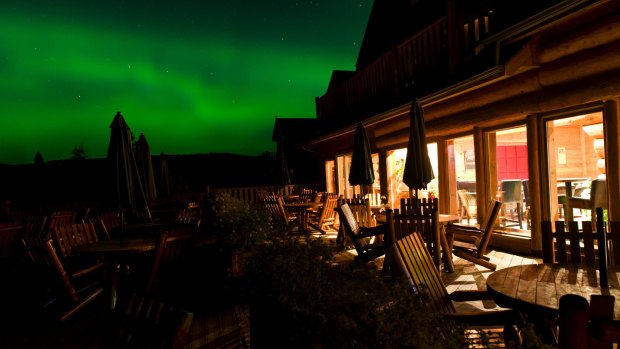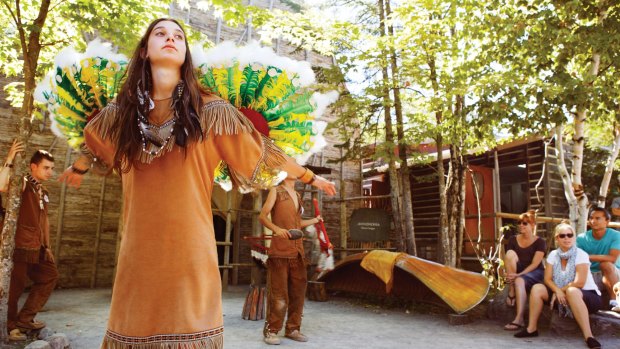This was published 5 years ago
Quebec, Canada travel guide: 10 things that will surprise visitors
By Max Anderson

Half of Quebec's population lives in Quebec City and Montreal.Credit: Shutterstock
Most travellers experience Quebec through Montreal or Quebec City. But away from the city lights and the cruise ships, the province that was 'born under the lily and grew up under the rose' offers a rugged destination that's as curious as it is compelling. Here are 10 reasons why Canada's French-speaking province might just surprise you…
1. IT'S QUIRKY
In Quebec there's a swear word you should never use. Ever.

Hotel Sacacomie.
Unique to Quebecers, the French derivation of the word "tabernacle" is a curse of ferocious power. It originated with the swarthy French settlers who came to fish for cod and hunt for fur in the 17th century. They were staunch Catholics, and in a frontier beset by bears, blizzards and the British, it was a brave person who angered the Lord by using biblical terms in vain. The word – which isn't a million miles from "tabernacle" – is considered far worse than any four-letter English profanity and has been known to start fights.
Today the Quebecoise language, like the T-bomb, is a powerful thing. It has been forged by history and isolation, and although French speakers number just a fifth of Canada's population, they're a cornerstone of the bi-lingual nation.
Their spoken French is considered coarse, slangy and heavily accented, but it is not the prickly barricade that English-speakers sometimes expect.

Wendake, the Huron-Wendat reserve.
Indeed I'm disarmed to find Quebecers are rather humble. Away from the cities, in the candy-coloured villages of Lanaudière, for instance, people give a little start when asked if they speak English and immediately begin apologising for their poor language skills. Some speak no English at all, and in the North American landscape, it feels incongruous and exotic.
Not unrelated, during my visit I hear no American, British or Australian accents in the wilderness lodges because the overseas visitors are almost entirely from France. One of the most unexpected pleasures is watching rugged, capable and wry Quebecers helping their uptight, sometimes demanding European forebears to slow down, chill out and smell the maples.
2. ITS DAM ENGINEERS
Canada's largest province is mostly wilderness – and much of it has been shaped by teeth.
Quebec is three times the size of France yet populated by just eight million people – and half of them live in Montreal and Quebec City. This leaves a lot of wild, under-populated country. Two-thirds of the province is under forest. Its lakes number half a million.
Flying over Lake Sacacomie in a float plane, I'm struck how the Laurentian Mountains seem untamed, the great forests running into autumn horizons that stretch forever. But as the pilot points out, the ecosystem is being actively managed, all night, every night.
"You can see it happening," he says, indicating a chain of smaller lakes like silver platters, each bisected by lines of fallen timber. "See those lines? They're beaver dams."
It turns out that beavers dam the rivers and flood the immediate forest. This kills the surrounding trees, providing more fallen timber, which they use as food and building materials. Maintaining the dam serves to semi-submerge their lodge and makes it impervious to predators.
It's not only clever, it's radical. Indeed, the beaver's ability to alter the landscape is said to be second only to one other species – human beings.
3. BUSY BEAVERS
Beavers appear to be muck like they appear to be in cartoons – insanely busy.
Hôtel Sacacomie (sacacomie.com) is a towering lakeside lodge fashioned from enormous pine logs. It employs a guide called Gaspard Bourque, an ex-trapper who wears a red checked jacket and a shapeless hat with a long feather in it.
At twilight, Gaspard leads our group into the surrounding forest of birch and maple to a small lake. We take up position beside a messy dam of mud and logs, which does a remarkable job of holding back the body of water.
"There are one million beavers in Quebec Province," says Gaspard. "Each beaver can cut through a 30-centimetre diameter tree in 55 minutes." After judging the hour by the low evening light, he declares the animals are about to begin their nightly labours.
He emits a long two-tone whistle which carries over the still waters. We wait awhile, listening to honking geese trailing overhead. He gives another whistle and – "here she comes."
The beaver is about 20 kilograms, like a small dog, gliding over to within five metres of us. She starts work on a floating log, immediately pitting her razor-sharp teeth against the bark and pith. The noise is extraordinary – tchikka-tchikka-tchikka – like a little machine. She rolls the log with her paws, gnawing away, reducing the log as we watch.
"The French arrived here 500 years ago and were happy to learn about nature. I've been here 69 years, and I'm still learning about the beaver."
4. ITS GREAT OUTDOORS
"Animation" is the French term for activities, and staying animated is as much a way of life in Quebec as it is in the rest of Canada.
Auberge du Lac Toureau (lactaureau.com) is a classic Quebec wilderness resort where people indulge in the great outdoors. Behind the resort is dense forest with 23 kilometres of trails; and out front is 95 square kilometres of lake.
In summer, you can explore the forest with a guide on foot, on a quad bike or on a horse – animations that come with some extra frisson since the forest is home to bears and wolves. As for the lake, it conceals 45 islands, most accessible only by kayak, canoe or pedal boat. The resort also has jet skis which offer a quicker, rather more glamorous means of washing up on golden beaches that sometimes haven't seen a footprint in weeks.
After November, the resort switches to a menu of winter animations, including snow-shoeing, dog-sledding, snow-mobiling and cross-country skiing.
5. ITS SPA CULTURE
Quebecers love their al fresco spa baths, the perfect antidote to the thing that probably defines them – the winter. Most wilderness retreats have a natural spa of some sorts, often fashioned from a stream or lake. The water is diverted and heated geothermally to a soothing 37 degrees; it's usually accompanied by an ice-cold plunge pool (used to keep the blood moving), and a bottle of wine to ensure the pleasures of spa don't succumb to any "body-is-a-temple" nonsense.
I discover the zenith of Quebec spa culture at La Source Bains Nordiques (lasourcespa.com) near the town of Rawdon. Set in 600 acres, it has a dozen pools fashioned into a deep gully of maple trees on Mont Pontbriand. It borrows at once from Scandinavian spa, eastern meditation and First Nation sensibilities (a few small campfires sending up fragrant smoke). Eco-structures are fashioned from timber and mountain stone, offering a Bistro, spa therapy spaces and an extraordinary Dark Room where you can let your mind go walkabout in zero-light conditions.
6. ITS SUGAR SNACKS
Kevin Fournier owns the Auberge du Vieux Moulin (auberge-lanaudiere.com/en), a boutique wilderness retreat on Goyer Lake. As well as his beautiful 20-room timber lodge, he has a deer enclosure, walking trails, two tipis and a thing close to Quebecers' hearts, a traditional sugar shack. The sugar shack is a small log cabin with a red roof, located at the bottom of a slope forested with maples. It's attached to some 2000 trees by a network of long thin tubes. In February, when the winter temperatures begin to oscillate between minus-seven and seven degrees centigrade, the sap begins to rise and the trees act like blood donors, feeding sweet watery nectar into the shack's 1000-litre tank.
"Sugar season lasts for around six weeks," says Kevin. "And during that time I practically live in here." For 14 hours each day, he's cooped up in his fragrant man cave, tending a great silver trough – a wood-fired "evaporator" – to slowly reduce every 40 litres of maple water to a single litre of syrup.
"We add nothing to maple syrup, it's just sap, and natural minerals like calcium and iron. Many Quebecers won't use sugar – only maple syrup."
7. PARDON THE FRENCH
"Kebec" is an Algonquin First Nation word meaning "where the river narrows". This refers to a constriction along the Saint Lawrence that became the strategic location of present day Quebec City (established by the French then conquered by the British). The word was Frenchified with the "Qu".
Quebec's First Nation peoples number 11 ethnic groups and are a significant part of Quebec's story. Historically, French settlers regarded them as trading partners and sources of valuable survival skills. Trappers often learned local languages, dressed in local style and married into tribes.
Today, many Quebec resorts offer First Nation cultural experiences. For instance, at Hotel Sacacomie I paddle a traditional rabaska canoe, eat bannock (native American bread) and learn to throw a hatchet.
One of the most profound – and successful – First Nation experiences is to be had outside Quebec City, in a beautiful new hotel, designed and operated by the Huron-Wendat people. Called Hôtel-Musée Premières Nations (tourismewendake.ca), the contemporary structure is in Wendake, the Huron-Wendat reserve. It incorporates a first-class museum with a reconstruction of a pre-European settlement. The hotel restaurant, La Traite, is a standout, serving an indigenous-influence menu including the like of elk tartare, venison rack in birch syrup, and fish soup with balsam fir green oil.
8. COMFORT FOOD
Chez Dany Sugar Shack (cabanechezdany.com) in Trois Rivieres seats 300. It's all trestle tables, chequered red cloths and a raucous joie de vivre which owes much to the fact everyone is buzzing on syrup.
As a fiddler smashes through some hard-core reels, I'm served a set menu – a blizzard of plates that are traditionally enjoyed by Quebecers in February when winter's end is nigh and the syrup is coming on-stream. The service comprises (deep breath): a bowl of salted pork scratchings; beer; bean soup; more beer; a plate of pork mince pie, egg flan and house-made baked beans all slathered in maple syrup; beer; pickled beetroot; whiskey with maple syrup; pancakes; and beer.
Though liable to send dieticians screaming for the hills, I'm confident this is a meal that is served somewhere in heaven.
9. ITS SURPRISINGLY AFFORDABLE
A generous suite in the Auberge du Vieux Moulin costs from $280 per couple per night, including breakfasts, five-course dinners and use of all non-motorised lake equipment. Lake Sacacomie – the Canadian equivalent of a five-star retreat – costs from $196 twin share per night.
You can spend a whole day lounging around the pools at La Source for just $47, or $28 for an evening.
A superb six-course degustation at Wendake costs a very reasonable $82. And the Chez Dany Sugar Shack carb 'n' syrup fest is $24 for all you can eat, plus cost of beer.
10. ITS WORDPLAY
In 1914, Canada faced a problem recruiting French-speaking soldiers. The Quebecers were piqued because French was being forbidden in schools and officers were English-speakers. So after some political pressure, a French-speaking infantry regiment was formed. It was the forerunner of what's now the largest infantry regiment in Canada, the Royal 22e Régiment.
Even today, the regiment may only be referred to in its French form, not its English equivalent. So you have been warned: call it the "Royal 22nd Regiment" and you're in strife. If you really can't get your tongue around the French, Quebecers have sanctioned use of the term "Van-doos", which is a simpler Anglophone rendering of "vingt-deuxieme" (22nd).
It's another beautiful quirk of Quebec. And so too is the regimental motto, three rather lovely words which certainly bear repeating.
Je me souviens means "I remember". Though referencing sacrifice, it's said also to remind Quebecers they were born under the French lily but grew under the English rose – that they are a cross-pollination of ideas, ambitions and cultures that have survived against the odds and evolved into something unique.
Don't be surprised if you're completely won over.
Max Anderson travelled as a guest of Québec Original
See also: The 10 things Australians need to understand about Canadians
See also: How the Trudeaus made Canada one of the world's most intriguing countries
Sign up for the Traveller Deals newsletter
Get exclusive travel deals delivered straight to your inbox. Sign up now.